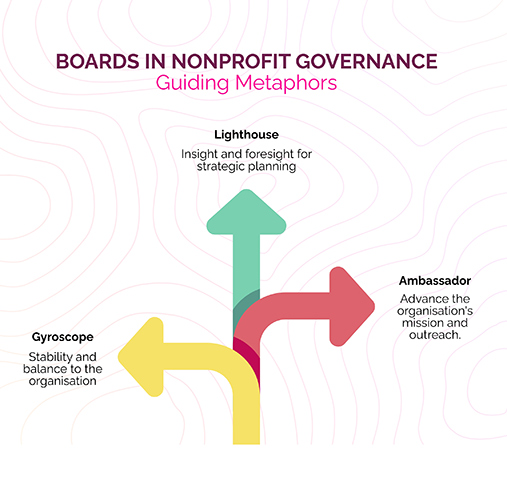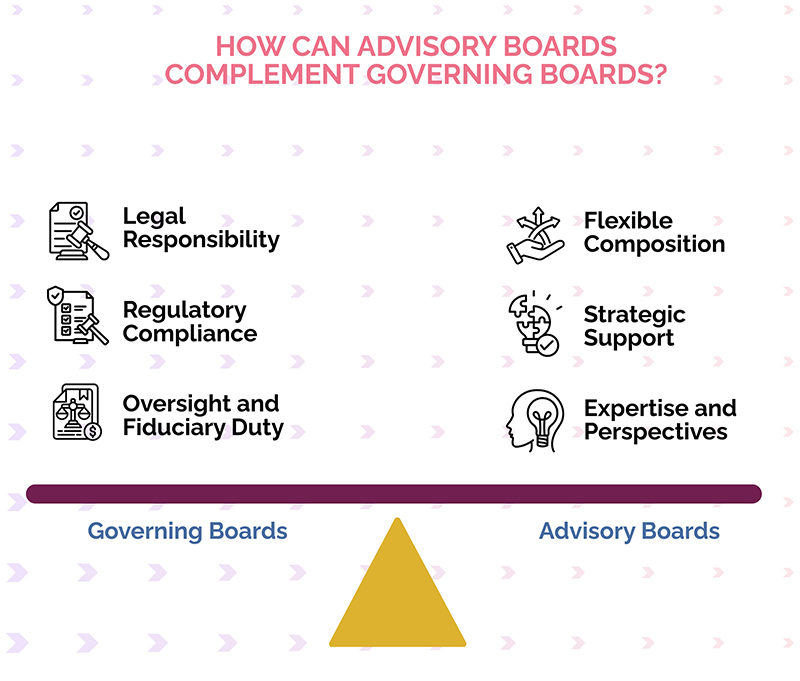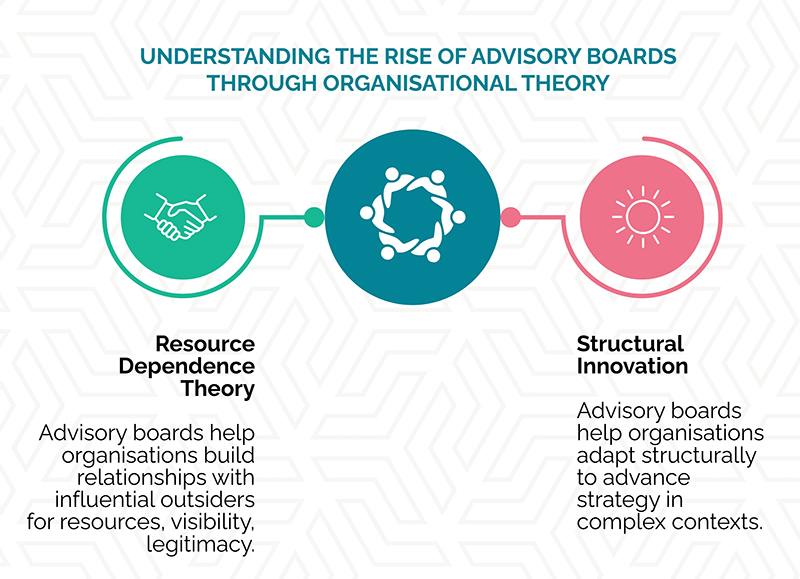Cover Story
Evolving Role of Boards in the Social Sector:
A Governance Blueprint
Nonprofit organisations require robust and transparent governance, clear accountability, strategic foresight, and strong on-ground engagement.
Governance remains a central question for the sector. Nonprofit governance can be understood as ‘the systems and processes concerned with ensuring the overall direction, control, and accountability of the organisation.’[1] Within the larger framework of board governance, strong statutory boards are an essential component to ensure that a nonprofit organisation is effective in its mission and compliant with the regulatory context that governs its work. Alongside, advisory boards have been emerging as a structure to enable organisations to meet their strategic needs.
Well-functioning boards are critical to the effective functioning of a nonprofit organisation. Effective boards improve organisational performance in many ways. In fact, the board is one of the key structures for an organisation’s governance, which is a process shaped by multiple other structures – executive leadership teams, internal policies, financial management systems, risk management frameworks, and operational procedures. Together, they play a role in ensuring accountability, strategic direction, and organisational effectiveness.
The adoption of advisory boards as part of integrated governance systems is gaining traction globally, with businesses, nonprofits, and industry bodies using them to navigate complexity through strategic guidance, diverse perspectives, and agile leadership.

The adoption of advisory boards as part of integrated governance systems is gaining traction globally, with businesses, nonprofits, and industry bodies using them to navigate complexity through strategic guidance, diverse perspectives, and agile leadership. Our research suggests that similar momentum is emerging in India’s nonprofit sector, where nonprofit organisations are beginning to see advisory boards as a way to strengthen governance, complement statutory boards, and access specialised expertise to address evolving challenges. Together, advisory and statutory boards create a comprehensive two-tiered model of governance that has the potential to strengthen compliance, strategy, and foresight.
Situated within the Indian nonprofit ecosystem,[2] this research study explores advisory boards in India as complementary structures to statutory boards, designed to reinforce nonprofit governance and enhance organisational effectiveness. The report aims to serve as a sector-wide resource on how advisory boards can strengthen nonprofit strategy, performance and governance in India, offering insights for nonprofit leaders, board members from the corporate sector, senior civil society leaders, funders, and participants of governance capacity-building initiatives like those by ILSS. Drawing on extensive research, the report also offers practical guidance to organisations on how to build and leverage advisory boards effectively.

The Case for Strong Nonprofit Governance
Governance is also defined as ‘the board’s legal authority to exercise power and authority over an organisation on behalf of the community it serves’.[3] Effective governance is widely recognised as a critical element in a nonprofit organisation’s ability to achieve impact. Studies have shown that nonprofit organisations with strong governance systems are better equipped to use their resources efficiently, uphold accountability to stakeholders, and respond to changing conditions.[4] Boards shape the foundation of strong governance in an organisation. Understanding the legal, ethical, and practical foundations of strong governance is key to seeing how a two-tiered model, combining the benefits of statutory and advisory boards, strengthens nonprofits.[5]
Governing boards are mandated by law to assume fiduciary responsibility for the organisation’s well-being, ensuring compliance with regulatory requirements and safeguarding against misuse of resources. Advisory boards can supplement the legal responsibilities of governing boards by providing subject matter expertise, strategic guidance, and innovation support.
Governing boards are mandated by law to assume fiduciary responsibility for the organisation’s well-being, ensuring compliance with regulatory requirements and safeguarding against misuse of resources. Advisory boards can supplement the legal responsibilities of governing boards by providing subject matter expertise, strategic guidance, and innovation support.
As described metaphorically by some of our interview respondents, boards act as a gyroscope[6] providing stability, a lighthouse[7] offering insight and foresight, and an ambassador[8] advancing the organisation’s mission. If designed intentionally, advisory boards may complement governing boards to form a two-tiered model of governance that offers stability, foresight and ambassadorship
Understanding governing boards and advisory boards – principles, practice, and global trends
Not-for-profit organisations in India are typically incorporated as Trusts, Societies, or Section 8 companies. Governing boards are bodies mandated by law to ensure legal and regulatory compliance and have legal discretionary power. The governing board refers to a managing committee or governing board in the case of a Society, trustees in the case of a Trust, and a Board of Directors in the case of a Section 8 company.[9]
Alongside governing boards, many organisations also establish advisory boards. Advisory boards provide guidance, inform strategy, and build connections in support of the organisation’s mission.

- A purpose-driven advisory board can be “self-defined” by organisations to focus on areas such as fundraising, partnerships, or organisational development.[11]
- Unlike governing boards, changes in advisory board composition are not subject to regulatory approval or reporting requirements with bodies such as the Office of the Charities Commissioner or Registrar of Companies.[12] This allows organisations to adapt the composition of advisory boards in response to their strategic or programmatic needs.
- Advisory boards may be constituted under different names, such as advisory councils or steering committees. Some experts are of the opinion that these names are preferred rather than ‘advisory boards’ to minimise conflation or confusion.[13]
- An advisory board or group may be established temporarily for a specific purpose/project[14] or as a permanent part of an organisation’s broader governance system.[15]
- These allow organisations to bring committed evangelists and supporters into their fold without crowding the statutory board.[16]
- Advisory boards may offer a platform to engage with trusted stakeholders (such as former governing board members, who hold valuable institutional memory) after the expiration of their board term.[17]

The growing phenomenon of advisory boards can be explained through the lens of organisational theory.[18] A 1998 essay titled Expanding the Governance Construct: Functions and Contributions of Nonprofit Advisory Groups attributes this phenomenon to two key ideas from organisational theory: resource dependence and structural innovation. The essay argues that advisory boards help nonprofits build relationships with influential outsiders, giving them access to resources, legitimacy, and strategic support. At the same time, advisory boards represent a structural innovation, helping organisations adapt to complex external environments and build internal expertise.
More recently, the Advisory Board Centre’s ‘State of the Market 2025-2027’ report highlights three global megatrends shaping the evolution of advisory boards across sectors. These are:
- Aligning advisory boards with broader organisational governance,
- Using advisory boards and their expertise to help organisation leaders make confident decisions.
- Balancing short-term actions with long-term strategy, especially in uncertain environments.[19]
Our research finds that these global, cross-sectoral trends find resonance in the Indian nonprofit sector as well.
- Nonprofit organisations are increasingly viewing advisory boards as a mechanism that can enhance governance by complementing statutory boards with technical expertise, diverse perspectives, and specialised counsel. From our research, we see that many organisations that currently do not have advisory boards are beginning to think about the strategic value this additional body can bring to their governance model.
- Our research indicates that organisations are bringing on members to their advisory boards for expertise on a variety of subjects – fundraising, strategy, evaluation, digital transformation – thus equipping organisation leaders with insights and confidence to respond effectively in complex environments.
- Finally, social purpose organisations are increasingly seeking to leverage the flexibility and adaptability of advisory boards to address questions of organisational resilience and program relevance, thereby balancing short-term responsiveness with long-term strategy. Our research suggests that advisory boards are increasingly becoming valuable ‘thought partners’ to organisations, supporting them not only in fundraising but also in longer-term strategic questions – such as leadership development, scale, and sustainability.

As the operating context of social purpose organisations changes rapidly, advisory boards are becoming structures for adaptive planning that enable organisations to remain agile in the face of uncertainty.
- David Renz, William Brown, and Fredrik Anderrson, “The Evolution of Nonprofit Governance Research: Reflections, Insights, and Next Steps,” Nonprofit and Voluntary Sector Quarterly, no.52 (2023): 243, https://doi.org/10.1177/08997640221111011
- As per data from 2015, 2.9 lakh charitable entities filed income tax returns. Many stakeholders in India’s non-profit sector see this as an important filter to accurately estimate the number of non-profit organisations in India. This number may have changed since 2015.
- BoardSource, “What is Governance“” in The Handbook of Nonprofit Governance (BoardSource, 2010)
- Michael Tugyetwena, “A literature review of the relationship between governance, funding strategy and sustainability of non-government organizations,” International NGO Journal. no.2 (2023). DOI:10.5897/INGOJ2023.0365
- BoardSource, “What is Governance“” in The Handbook of Nonprofit Governance (BoardSource, 2010)
- Maharshi Vaishnav, July 8 2025
- Archana Ramachandran, June 6 2025
- Jagdish Acharya, July 9 2025
- Noshir Dadrawala, Governance of Non-profit Organisations in India. (Centre for Advancement of Philanthropy, 2024). Chapter V, https://www.icnl.org/wp-content/uploads/Noshir-Dadrawala_CAP-Book_23Sept24_Final.pdf
- Ritu Kochhar, July 31 2025
- Anne Wallestad, “The Four Principles of Purpose-Driven Board Leadership,” Stanford Social Innovation Review, March 10, 2021, https://ssir.org/articles/entry/the_four_principles_of_purpose_driven_board_leadership
- Noshir Dadrawala, July 8 2025
- Noshir Dadrawala, July 8 2025
- Niveditha Menon (June 20 2025), Kathy Reich (June 24 2025)
- “What are Advisory Board Roles and Responsibilities,” Advisory Board Centre, https://www.advisoryboardcentre.com/insight/how-to-structure-an-advisory-board/
- Matthew Forti, “Challenging Conventional Wisdom on Nonprofit Boards,” Stanford Social Innovation Review, February 13, 2018, https://ssir.org/articles/entry/challenging_conventional_wisdom_on_nonprofit_boards#
- Niveditha Menon (June 20 2025) “Guidelines to Form a Nonprofit Advisory Board,” Authenticity Consulting LLC. https://management.org/misc/Nonprofit-Advisory-Board.pdf
- Judith Saidel, “Expanding the Governance Construct: Functions and Contributions of Nonprofit Advisory Groups,” Nonprofit and Voluntary Sector Quarterly, no.4 (1998): 423, https://doi.org/10.1177/0899764098274003
- “2025-2027 State of the Market:Exploring the Art and Science of Advisory Board Practice”, Advisory Board Centre, pg 5. https://www.advisoryboardcentre.com/our-research/state-of-the-market/
Copyright © 2024 India Leaders For Social Sector
